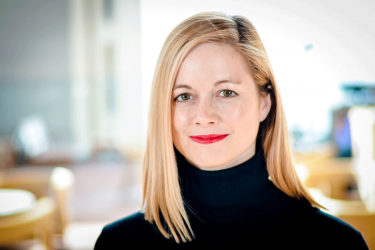Profile: Molly Kocour Boyle
Meet Molly Kocour Boyle. President of AT&T Ohio.
Name: Molly Kocour Boyle
Job: President - AT&T Ohio
City: Columbus
Hometown: Lawrence, KS
Q: Tell us about your work...
As president of AT&T Ohio, I focus on developing the overall strategic direction of AT&T’s public policy, economic development, and community engagement activities across the state. I and members of the AT&T Ohio External Affairs team work closely with state and local policymakers and business and community leaders to foster an environment that welcomes investment and innovation, focuses on bringing new technologies that drive innovation and create jobs, and provides educational and economic opportunities that empower Ohioans to improve the quality of life for all. Prior to joining the AT&T Ohio team last year, I was the president of AT&T Kansas and served the company in Public Affairs and External Affairs roles prior to that.
Q: What’s a challenge you're working to solve?
Our purpose at AT&T is connecting people to greater possibility. The key areas of focus in that work are broadband access, affordability, and adoption. We have a shared goal to close the digital divide, which is the gap between those who have a broadband connection – and the tools to use it – and those who do not. We must work as partners with elected officials, community leaders and nonprofit organizations to connect Ohioans to greater possibility by closing that digital divide. One part of the challenge is that neither the private sector nor the public sector can do it all alone, we each have important roles to play. AT&T is investing in infrastructure and providing resources, technology and digital learning solutions to help get more Ohioans online. We know that being able to connect to the internet means having access to opportunities in education, telehealth, business, employment, and innovation. We want to help ensure everyone can participate in today’s digital world.
Q: What’s a lesson you’ve learned that's shaped your work?
The importance of collaboration. That’s the way we find the best path forward. This certainly applies to our work to close the digital divide. The barriers to broadband access, adoption and affordability don’t occur in silos – they’re often interrelated and can create a push-pull effect further hindering people who are already struggling to get online. The good news is, we’re at a moment in time when there is recognition of these interrelated concerns at all levels: federal, state, and local. This is what now presents us with a once-in-a-generation opportunity to deliver transformative change and bring broadband’s benefits to more and more people.
Q: What’s a trend in technology or innovation that doesn’t get enough attention?
As we focus on broadband connections, both for individuals and for business use, there’s a great deal of attention on future-proof technology such as fiber, because of its scalable network architecture that is multi-gig capable from the day it’s installed. But mobile broadband… specifically 5G technology… is also a key part of the technology equation. With 5G, you can send and receive large quantities of data more quickly with less lag. That’s important when real-time processing is vital, like for autonomous vehicles, or for technologies like AR – augmented reality – that use 3D holographic displays. AR has the potential to revolutionize learning environments in healthcare, education, manufacturing, workforce development and more. So, it’s important to keep in mind that fiber and 5G are interrelated: fiber is the backbone of 5G. Where fiber goes, wireless follows. We expect data usage to increase 5 times just between 2021-2025. 5G and fiber will serve as the digital foundation for the U.S. economy for the next decade.
Q: What’s one moonshot idea that could help make Ohio a world leader in technology and innovation?
While a moonshot idea would be something disruptive, addressing a problem that seems impossible to solve, there’s a goal that seems very reachable that would put Ohio on the leadership path in technology and innovation: ensuring that every student in every school has the opportunity to learn computer science. It’s a message that business, education, nonprofit and public sector leaders have been sharing in all 50 states. Computer science provides an essential foundation, not only for careers in technology, but for every career in today’s world. Education experts indicated last year that 48% of Ohio’s high schools offer computer science courses. In more than a dozen states, that number was up in the 70% to 90% range, so there’s room for meaningful progress that could make a very real difference for our children and our state.
Q: What’s a recent book, podcast, or news story that you found interesting?
I saw an engaging Forbes article last week that discussed 5G mobile broadband networks and the difference they will make for augmented reality applications. It suggested the potential for use of AR in construction sites for example, where AR could offer 3D displays that would allow a worker to visualize their creations before they begin to work on them. It described the possible use of AR in healthcare settings, such as allowing doctors to overlay 3D virtual instructions with millimeter-level accuracy onto a patient's body. It’s exciting to contemplate how technologies of this sort will complement and enable each other to generate uses that still seem like science-fiction today.
Q: What's your favorite place in Ohio?
I appreciate the geographic diversity of Ohio. As a newer resident of the Buckeye State, I’m still exploring and enjoying all that Ohio has to offer. One of my favorite things about our state is its geographic variety. From the North Coast, up along Lake Erie, to the beautiful hills and hollows in our Appalachian area, to our MetroParks systems, there really is something for everyone here.
Q: What makes Ohio special to you?
My husband is a native of Northeast Ohio, so we have family here and that made the opportunity to work here, live here and raise our children here very special.

